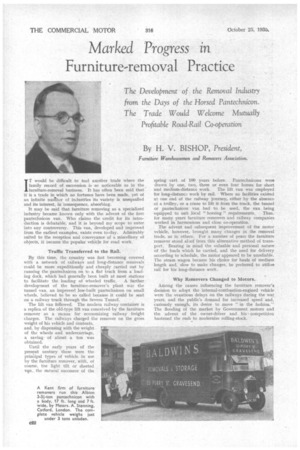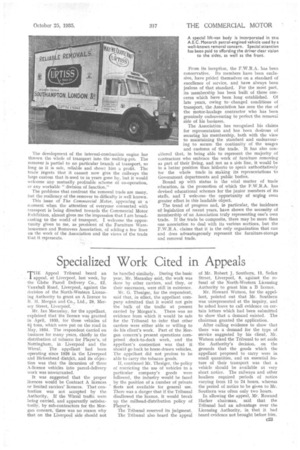Marked Progress in Furniture-removal Practice
Page 64

Page 65

If you've noticed an error in this article please click here to report it so we can fix it.
The Development of the Removal Industry from the Days of the Horsed Pantechnicon. The Trade Would Welcome Mutually Profitable Road-Rail Co-operation /T would be difficult to find another trade where the family record of succession is so noticeable as in the furniture-removal business. It has often been said that it is a trade in which no fortunes have been made, yet of an infinite nunfiber of industries its variety is unequalled and its interest, in 'consequence, absorbing.
It may be said that furniture removing as a specialized industry became known only with the advent of the first pantechnicon van. Who claims the credit for its introduction is debatable, and it is beyond my scope to enter into any controversy. This van, developed and improved from the earliest examples, exists even to-day. Admirably suited to the reception and conveyance of a miscellany of objects, it became the popular vehicle for road work.
Traffic Transferred to the Rail.
By this time, the country was fast becoming covered with a network of railways and long-distance removals could be snore expeditiously and cheaply carried out by running the pantechnicon on to a flat truck from a loading dock, which had generally been built at most stations
to facilitate the loading of wheeled traffic. A further development of the furniture-remover's plant was the tunnel van, an improved low-built pantechnicon on small wheels, believed to be so called because it could be sent on a railway truck through the Severn Tunnel.
The lift van followed. The modern railway container is a replica of the old-type lift van conceived by the furniture remover as a means for economizing railway freight charges. The railways charged the remover on the gross weight of his vehicle and contents, and, by dispensing with the weight of the wheels and undercarriage, a saving • of about a ton was obtained.
Until the early years of the present century these were the principal types of vehicle in use by the furniture remover, with, ot course, the light tilt or sheeted van, the natural successor of the
spring cart of 100 years before. Pantechnicons were drawn by one, two, three or even four horses for short and medium-distance work. The lift van was employed for long-distance work by rail. Where no facilities existed at one end of the railway journey, either by the absence of a trolley, or a crane to lift it from the truck, the tunnel or pantechnicon van had to be used, the van being
equipped to suit local " horsing" requirements. Thus, for many years furniture removers and railway companies worked in harmonious and close co-operation.
The advent and subsequent improvement of the motor vehicle, however, brought many changes in the removal ttade, as in others. For a number of years the furniture remover stood al...)of from this alternative method of transport. Bearing in mind the valuable and personal nature of the loads which he carried, and the need for delivery according to schedule, the motor appeared to be unreliable. The steam wagon became his choice for hauls of mediutn length and, slow to make changes, he preferred to utilize rail for his long-distance work.
Why Removers Changed to Motors.
Among the causes influencing the furniture remover's decision to adopt the internal-combustion-engined vehicle were ihe vexatious delays on the railways during the war years, and the public's demand for increased speed and, curiously enough, its desire to move "in the fashion." The flooding of the market by Government motors and the advent of the owner-driver and his competition hastened the rush to modernize rolling-stock.
The development of the internal-combustion engine has thrown the whole of transport into the melting-pot. The remover is partial to no particular branch of transport, so long as it is safe, reliable and how c him a profit. The trade regrets that it cannot now giVe the railways the large custom that it. used to in years gone by, but it would welcome any mutually profitable scheme of co-operation, or any workable " division of function."
The problems that confront the removal trade are many, hut the resiliency of the remover to difficulty is well known.
This issue of The Commercial Motor, appearing at -a • moment when the attention of everyone connected with transport is -being directed towards the Commercial Motor Exhibition, almost gives me the impression that I ant broadcasting to the World of transport. I welcome the opportunity given to me, as president of the Furniture Warehousemen and Removers Association, of adding a few lines on the work of the Association and the views of the trade that it represents. From its inception, the F.W.R.A. has been conservative. Its members have been exclusive, have prided themselves on a standard of excellence of service, and have always been jealous of that standard. For the most part, its membership has been built of those concerns which have been long established. Of late years, owing to changed conditions of transport, the Association has seen the rise of the motor-haulage contractor who has been genuinely endeavouring to perfect the removal side of his business.
The Association has recognized his claims for representation and has been desirous of securing his membership, both with the view to maintaining the standard and endeavouring to secure the continuity of the usages and customs of the trade. It has also considered that, in being able to represent the majority of contractors who embrace the work of furniture removing as part of their living, and not as a side line, it would be in a better position than hitherto to speak authoritatively for the whole trade in making its representations to Government departments and public bodies.
Bound up with status is the vital matter of trade education, in the promotion of which the F.W.R.A. has devised educational schemes for the junior members of its staffs, and I welcomethe opportunity of urging even greater effort in Ibis laudable object. The trend of progress and, in particular, the incidence of legislation of recent years, have shown the necessity of membership of an Association truly representing one's own trade. If the trade be composite, there may be more than one association to deal with its variOus sections, but the F.W.R.A. claims that it is the only organization that can and does advantageously represent the furniture-storage and removal trade.
















































































































































